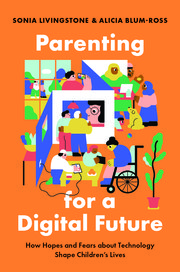In Parenting for a Digital Future: How Hopes and Fears about Technology Shape Children’s Lives, Sonia Livingstone and Alicia Blum-Ross present a timely and critical examination of different families’ relationships with digital technologies and how parents perceive and manage their children’s experiences and practices. This book does a very successful job of shedding light on parents’ perspectives of digital technology, going beyond polarised accounts and hinting at the radical and comprehensive effort required to address the social and individual dilemmas of parenting in the digital age, writes Bengi Süllü. This post was originally published on the LSE Review of Books blog.
If you are interested in the topics explored in this book, you can sign up to attend the LSE event ‘Digital Technologies in the Lives of Children and Young People’, which is being held on Friday 18 September 2020.
Parenting for a Digital Future: How Hopes and Fears about Technology Shape Children’s Lives. Sonia Livingstone and Alicia Blum-Ross. Oxford University Press. 2020.
 There has rarely been a question so central for families with children in the postindustrial world in the last decade as ‘how much time with digital technology is too much?’. In recent months, however, questions about digital technology have been rapidly evolving and expanding considering the number and variety of families with young people in their household whose experience of the COVID-19 pandemic has been shaped by the shifting of face-to-face education, communication and leisure activities to online.
There has rarely been a question so central for families with children in the postindustrial world in the last decade as ‘how much time with digital technology is too much?’. In recent months, however, questions about digital technology have been rapidly evolving and expanding considering the number and variety of families with young people in their household whose experience of the COVID-19 pandemic has been shaped by the shifting of face-to-face education, communication and leisure activities to online.
Sonia Livingstone and Alicia Blum-Ross’ new book, Parenting for a Digital Future, published during this historical moment in our lives, presents a timely and critical examination of families’ relationship to and understanding of digital technologies and how parents perceive and manage their children’s practices. The authors conducted an in-depth qualitative study of 73 families in London in 2015 and 2016, supported by ‘a survey of 2,000 parents across the United Kingdom in late 2017’ (page 24), looking at ‘parenting practices, values and imaginaries’ (24) in relation to the place of digital technology in their children’s and their lives. Livingstone and Blum-Ross underline the diverse social, cultural and economic backgrounds of the parents, but acknowledge that many of the participants ‘felt they had something to say about parenting and/or children and technology’ (202).
The authors draw on a theoretical framework of the ‘risk society’, which depicts a shift in parenting practices alongside late capitalism in modern postindustrial society, entailing the mobilisation of individual resources on the part of parents to prepare one’s child(ren) for an uncertain and ever-changing future. Livingstone and Blum-Ross present an exploration of this mobilisation for an increasingly digitalising world with digital jobs, ‘including those not yet invented’ (71).
Even though the subtitle alludes to ‘hopes and fears’ about technology in shaping children’s lives, the authors excel in illuminating the prevailing shift in the contemporary discourse towards hopes over fears. This is tightly connected to structural changes in the postindustrial nation, which also manifest in public education discourse that puts ‘students to work at the very forefront of technological change’ (148), with coding classes for students almost mainstream. In the context of such all-encompassing and seemingly inevitable change, families’ approaches to digital technology no longer revolve around the one-dimensional ‘screen time’ discussion. Instead, they are evolving to manifest in ongoing negotiations over how to make the most of digital technology in various aspects of life.

In Chapters Two and Four, the authors skillfully elaborate on how digital technology operates as a medium through which certain recreational, communication or educational goals are attained by parents and families with different socio-economic backgrounds, opportunities and circumstances. They go beyond the existing essentialising notions about the relationship between children and digital technologies that dichotomously understand digital technology as either harmful or empowering. Instead, Livingstone and Blum-Ross strive to understand digital technologies as a mediator between different aspects of family life: namely, ‘home, school, work and interpersonal relationships’ (36). They underline how the popular discourse around digital technology and parenting based on negotiations of ‘screen time’ not only undermines the variety of relations and possibilities brought about by digital technologies, but also ignores the ways in which existing and deep socio-economic differences are reflected by parents in their ideas about digital technology as well as in parents’ differentiated access to digital technology. In this sense, ‘negotiations over technologies are often also, explicitly or implicitly, negotiations over gender or culture or resources’ (54).
An important contribution is the authors’ illustration of the temporal aspects of negotiating the use of digital technology, as they take a day of a family as a unit of analysis, which strikingly illustrates the dynamism and complexity of parental decisions. With one of their examples focusing on the sleep-time habits of a family with a child with autism, they show how:
technology presents challenges to sleep but also ways of easing into it (as in families who watch shows or listen to stories as part of winding down) and certainly gives respite to parents during busy days with kids or to relax themselves after their children have gone to sleep (52-53).
In Chapter Four, the authors further elaborate on the affordances of digital technology; beyond being an educational tool, digital technologies can help children with special educational needs find their skills and identity, restoring confidence and connection. Yet, they also show the stark contrast between the support network of actors and activities for well-off families’ children with special educational needs and that of a working-class family. With the former hiring a special assistant to accompany their child to a coding class and the latter mainly supported by a television at home, Livingstone and Blum-Ross demonstrate that:
embracing the digital is […] a relatively privileged phenomenon, requiring considerable educational and some economic capital and, as suggested earlier, also requiring the confidence to take a risk with the future (108).
They expand further on this argument in Chapter Three, ‘Social Inequality’, using Pierre Bourdieu’s conception of economic and cultural capital to underline how social inequality, in the forms of differences in families’ social, cultural and economic backgrounds and opportunities, shapes access to and use of digital technology and, in turn, gets reproduced in the process. As they revisit the classic work by Annette Lareau, Unequal Childhoods, they point to drawbacks in Lareau’s somewhat dichotomous conception of working-class kids who are left with plenty of free time versus middle- to upper-class kids who experience ‘concerted cultivation’ based on ‘a rigorous schedule of adult-organized out-of-school enrichment activities’ (61). With digital technology an integral component of a lot of these activities, Livingstone and Blum-Ross show that it’s not that parents from different classes have different expectations of their children. Rather, social, cultural and economic capital produce a significant divergence in the benefit that children of low-income and high-income families can get from digital technology, because their access to and relationship with digital technology are very different in the first place.
The differences between the physical technological landscapes in the homes of working-class and middle-to-upper-class families is laid out by the authors, not just reflecting the abundance of devices but also divergence in parental knowledge, experiences and connections, from the ability to regularly update devices to being able to afford the most current coding class. A striking example is the distinction that one family made between using digital technology as a producer/creator and using it merely as a consumer; the parents sought to ensure that their children fall into the first group, with the aim of one day becoming a leader in the new economy. So, even when ‘both wealthy and poor children are learning coding and other forms of technological expertise, the outcomes are very different’ (78).
The authors could have critically expanded on the discussion of children’s agency and negotiations in the modern family. They make a point about the overall decline of authoritarian styles of parenting and an increase in parents favouring negotiations with children, rather than simply shutting off digital devices, for instance. Yet, my contention is that the authors follow too closely an implicit assumption that is often present in contemporary studies of parenting from the postindustrial world that individualisation leads to an expansion of negotiations with children and of children’s agency. This observation, true at first glance, misses the point that the balance of authority and agency doesn’t only rest on the relationship between individuals, but is to a large extent structured by the political economic system. The authors do touch on this, but then seem to leave aside the way that the retraction of safety nets and the growing uncertainty this produces leaves parents as individualized, ‘responsibilized’ agents, strictly managing their children’s activities and trajectories in ways that do not leave much space for children’s agency.
As a result, in this study, what is presented is still very much a story of children who largely have to fit within the frame of what is already deemed doable and choosable by parents in a way that extends beyond digital technology, as is the case, for example, in selecting extracurricular activities: ‘Each choice was made after careful consideration of the pros and cons, to steer the children as much away from danger as toward a productive future’ (20). The postindustrial context that necessitates and facilitates the processes by which digital technology is evaluated, utilised and mobilised by parents also means that children’s ability to negotiate their own desires and choices might be largely compromised from the beginning. As a result, digital technology’s potential to unleash learning and development opportunities and facilitate communication between actors may not be materialised, at least not in a way that expands children’s agency.
In conclusion, Parenting for a Digital Future does a very successful job of shedding light on and bringing together parents’ perspectives and reflections on digital technology, as they take place in interactions with their children and educators in a wider social context. They go beyond the polarised accounts of digital technology that do not recognise its situatedness and the positions of the actors engaging with it. Most importantly, they contribute policy recommendations that highlight parents’ participation in the design, practice and mediation of digital environments, but also hint at the radical and comprehensive effort that is needed to address the social and individual dilemmas of parenting shaped by ‘intersectional issues like gender, class, race, (dis)ability, and more’ (194).
This post was originally published on the LSE Review of Books blog and is reposted with thanks. This review gives the views of the author, and not the position of the LSE Review of Books blog, nor of the Media@LSE blog, nor of the London School of Economics.
Image Credit: Nenad Stojkovic (CC BY 2.0).





